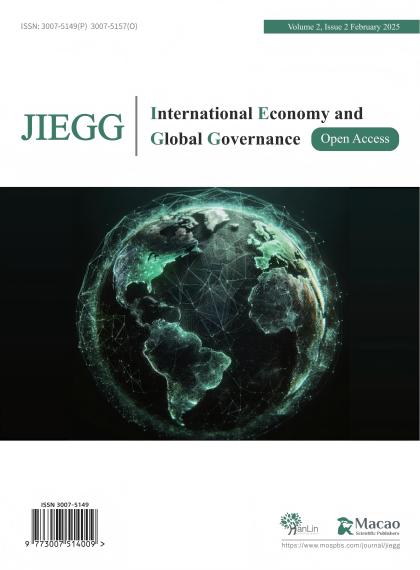-
Borrus, M., Tyson, L. D. A., & Zysman, J. (1986). Creating advantage: How government policies shape international trade in the semiconductor industry. In P. R. Krugman (Ed.), Strategic trade policy and the new international economics. MIT Press, 24-45.
-
Bown, C. P. (2020). How Trump’s export curbs on semiconductors and equipment hurt the U.S. technology sector. Peterson Institute for International Economics Blog. https://www.piie.com/blogs/trade-and-investment-policy-watch/how-trumps-export-curbs-semiconductors-and-equipment-hurt-s
-
Bull, H. (2003). The anarchical society (X. M. Zhang, Trans.). World Affairs Press,103.
-
Bloomberg. (2021, April 8). U.S. blacklists seven Chinese supercomputing firms. https://www.bloomberg.com/news/articles/2021-04-08/u-s-adds-seven-chinese-supercomputing-firms-to-export-ban-list.
-
Congressional Research Service. (2020). Semiconductors: U.S. industry, global competition, and federal policy.
-
Chi, Z. P. (2020). The implementation and constraints of U.S. technology containment strategy against China. Pacific Journal, (6), 27–42.
-
Drezner, D. (2001). State structure, technological leadership, and the maintenance of hegemony. Review of International Studies, 27(1), 3–25.
-
Emirbayer, M. (1997). Manifesto for a relational sociology. American Journal of Sociology, 103(2), 287.
-
Ezell, S. (2021, February 18). Moore’s law under attack: The impact of China’s policies on global semiconductor innovation. ITIF Reports & Briefings, 1–61.
-
Fei, X. T. (2006). From the soil. Shanghai People’s Publishing House.
-
Ferry, J., & Layton, R. (2021, March). Maintaining U.S. leadership in semiconductors and countering China’s threats. Coalition for a Prosperous America Report, 1–15.
-
Feng, J. F., & Guo, Q. H. (2021). The road of chips: Understanding the present and future of the integrated circuit industry in one book. China Machine Press,90–96.
-
Feng, Z. K. (2023). Sino–U.S. chip disputes: Reality, logic, and reflections. Asia-Pacific Security and Maritime Affairs, (2), 23–27.
-
Feng, Z. Z. (2018). Japan’s semiconductor industry development and U.S.–Japan semiconductor friction. Japan Studies, (3), 22–34.
-
Gantz, D. A. (1999). Lessons from the U.S.–Japan semiconductor dispute. In Dispute resolution in international trade ,91–125.
-
Hamilton, W. D. (1964). The genetical evolution of social behavior. Journal of Theoretical Biology, 7(1), 1–16.
-
Han, S. (2020). The evolution of U.S. export controls from key technologies to emerging and foundational technologies. Journal of Information, (12), 33–39.
-
Han, Z. Y., & Liu, J. (2023). The paradox of Biden’s “Chip 4 Alliance.” World Economy and Politics Forum, (3), 70–91.
-
Hatoyama, M. (1980). People who supported semiconductors. Seibundo Shinkosha.
-
Huang, C. C. (2015). Balance of relationship: The essence of Myanmar’s China policy. In Asian Politics ,189–210.
-
Huang, C. C. (2017). Embedded relationality and role: History and hierarchy in Vietnam’s China policy. Korean Political Science Review, 51(6), 133–135.
-
Huang, C. C., & Shih, C. Y. (2014). Harmonious intervention: China’s quest for relational security. Ashgate.
-
Huang, Z. L. (2022). “Internal and external cultivation”: The Biden administration’s technological competition with China. International Forum, (6), 86.
-
Huang, Z. L., & Han, Z. Y. (2023). Debates in the U.S. strategic community on China policy. Northeast Asia Forum, (4), 34–49.
-
Irwin, D. A. (1996). Trade policies and the semiconductor industry. In A. O. Krueger (Ed.), The political economy of American trade policy. University of Chicago Press,21–45.
-
Irwin, D. A., & Klenow, P. (1996). High-tech R&D subsidies: Estimating the effects of SEMATECH. Journal of International Economics, 40(3–4), 323–344.
-
Jackson, P. T., & Nexon, D. H. (1999). Relations before states: Substance, process and the study of world politics. European Journal of International Relations, 5(3), 307.
-
Jiang, Z. (2012). A study on the development space of the U.S.-Japan alliance from the perspective of its post-Cold War historical process. People’s Forum, (32), 254–255.
-
Kumar, S., & Krenner, N. (2002). Review of the semiconductor industry and technology roadmap. Journal of Science Education and Technology, 11(3), 229.
-
Lang, L. H., & Feng, X. (2021). Prospects for Sino–U.S. technological relations. Open Herald, (6).
-
Li, S. Z. (2011). The phenomenon of technological hegemonyy in multinational competition: A theoretical review and outlook. Social Scientist, (9), 106–107.
-
Lin, X. L. (2021). Techno-nationalism and U.S. high-tech containment of the Soviet Union and Japan. World Economy and Politics, (12), 131–132.
-
Liu, H. Z. (2019). Hegemony maintenance and transcendence: The political economy of global value chain competition in high-tech industries. Social Sciences Academic Press,145.
-
Ling, S. L., & Luo, J. Y. (2021). Biden’s “technology alliance”: Motives, content, and challenges. International Forum, (6).
-
March, J. G., & Olsen, J. P. (1998). The institutional dynamics of international political orders. International Organization, 52(4), 943–969.
-
Mastanduno, M. (1992). Economic containment: CoCom and the politics of East–West trade. Cornell University Press.
-
Morgenthau, H. J. (2005). Politics among nations (X. Xu, Trans.). Peking University Press, 46–47.
-
Moore, G. (1996). Intel: Memories and the microprocessor. Daedalus, 125(2), 55–56.
-
Morris, P. R. (2008). A history of the world semiconductor industry (p. 21). The Institution of Engineering and Technology.
-
Nordin, A. H. M., et al. (2019). Towards global relational theorizing: A dialogue between Sinophone and Anglophone scholarship on relationalism. Cambridge Review of International Affairs, 32(5), 572–573.
-
Nishimura, Y. (2016). The rise and fall of Japanese electronics (H. Hou, Trans.). People’s Posts and Telecommunications Press,11.
-
Okada, Y. (2006). Struggles for survival: Institutional and organizational changes in Japan’s high-tech industries. Springer Tokyo.
-
Peng, B., & Shi, C. (2021). A thousand years of trade wars: Trade conflicts and the rise and fall of great powers. Renmin University Press,236.
-
Qin, Y. Q. (2009). Relationalism and process construction: Embedding Chinese ideas into international relations theory. Social Sciences in China, (3), 74–77.
-
Qin, Y. Q. (2012). Guanxi and process: The cultural construction of China's international relations theory (Chinese ed.) . Shanghai Renmin Press, 40–41.
-
Qin, Y. Q. (2021). A Relational Theory of World Politics. Shanghai Renmin Press, 271–277,378,381,387.
-
Schutte, G. R. (2021). The challenge to U.S. hegemony and the “Gilpin Dilemma”. Revista Brasileira de Política Internacional, 64(1).
-
Shen, W., & Hu, Y. H. (2022). American minilateralism and U.S. reshaping of the global economic and trade system. International Forum, (1).
-
Shen, X. B. (2002). Chips: The bread of industrial development. Tsinghua University Press,33.
-
Shih, C. Y. (2013). Affirmative balance of the Singapore–Taiwan (China's Taiwan region) relationship: A bilateral perspective on the relational turn in international relations. Journal of Asian Studies, 72(3), 681.
-
Shih, C. Y., et al. (2019). China and international theory: The balance of relationships. Routledge.
-
Shultz, G. (1985). New realities and new ways of thinking. Foreign Affairs, 63(4), 78.
-
Semiconductor Industry Association. (2018, June 7). Beyond borders: The global semiconductor value chain spurs innovation and growth. https://www.semiconductors.org/wp-content/uploads/2018/06/SIA-Beyond-Borders-Report-FINAL-June-7.pdf
-
Su, C. H. (1997). Some reflections on balance of power theory. Europe, (4), 32–38.
-
Tang, X. H. (2021). The Western “technology alliance”: Strategic path to constructing new technological hegemony. Contemporary International Relations, (1), 38–46.
-
Tao, T., & Shi, K. Y. (2023). From U.S.–Japan to Sino–U.S. semiconductor conflicts: Motivations, nature, and impact. International Trade, (7), 24.
-
The White House. (2017, December). National security strategy of the United States of America. https://trumpwhitehouse.archives.gov/wp-content/uploads/2017/12/NSS-Final-12-18-2017-0905.pdf
-
The White House. (2021, June 3). Executive order on addressing the threat from securities investments that finance certain companies of the People’s Republic of China. https://www.whitehouse.gov/briefing-room/presidential-actions/2021/06/03/executive-order-on-addressing-the-threat-from-securities-investments-that-finance-certain-companies-of-the-peoples-republic-of-china/
-
The White House. (2022, October 12). National security strategy. https://bidenwhitehouse.archives.gov/wp-content/uploads/2022/10/Biden-Harris-Administrations-National-Security-Strategy-10.2022.pdf
-
Tyson, L. D. A. (1992). Who’s bashing whom? Trade conflict in high-technology industries. Institute for International Economics.
-
U.S. Congress, Office of Technology Assessment. (1979). Technology and East–West trade. Government Printing Office.
-
U.S. Department of Defense. (2018). Summary of the 2018 national defense strategy of the United States of America. https://media.defense.gov/2020/May/18/2002302061/-1/-1/1/2018-NATIONAL-DEFENSE-STRATEGY-SUMMARY.PDF
-
U.S.–China Economic and Security Review Commission. (2019). How Chinese companies facilitate technology transfer from the United States. https://www.uscc.gov/research/how-chinese-companies-facilitate-technology-transfer-united-states
-
Varas, A., et al. (2021, April). Strengthening the global semiconductor supply chain in an uncertain era. SIA/BCG Report, 1–53.
-
VerWey, J. (2019, July). Chinese semiconductor industrial policy: Past and present. USITC Journal of International Commerce and Economics. https://www.usitc.gov/publications/332/journals/chinese_semiconductor_industrial_policy_past_and_present_jice_july_2019
-
Wei, L. (2017). Relational balancing, ASEAN centrality, and the evolution of regional order. World Politics and Economics, (7), 46–47.
-
Waltz, K. (2003). Theory of international politics (Q. Xin, Trans.). Shanghai People’s Publishing House,154–170.
-
Wang, C. G. (2023a). Technological innovation and the reshaping of the international order. Contemporary World, (5).
-
Wang, C. G. (2023b). The history, reality, and trends of human civilization: A general discussion. People’s Forum, (10), 45–49.
-
Wang, F. (2024). China’s U.S. policy in the new era: Review, evaluation, and suggestions. Peace and Development, (4), 2–8.
-
Wang, J. S. (1992). The “strategic triangle” in U.S. policy toward China. American Studies, (2), 18.
-
Wang, J. S. (2024). The four logics behind Sino–U.S. rivalry. International Economic Review, (2), 11.
-
Wu, Z. L., & Li, Y. J. (2013). Are alliances among democracies more durable? Evidence from bilateral military alliances, 1815–1989. Contemporary Asia-Pacific, (3), 139–141, 152–153.
-
Xiao, Y. G. (2008). technological hegemony and its prevention under intellectual property protection. Special Zone Economy, (8), 251.
-
Xi, Y., & Cai, X. L. (2019). Japan’s responses to U.S.–Japan trade friction and its implications. Asia-Pacific Economy, (2), 92.
-
Yu, N. P., & Ji, S. M. (2021). The strategic background, goals, and dilemmas of building the Western “technology alliance.” Contemporary International Relations, (1), 47–54.
-
Zhai, X. W. (2019). A sociological exploration of “filial piety.” Society, (5), 134–140.
-
Zhang, J. X. (2006). Power and economic growth: The international political economy of U.S. trade policy. Shanghai People’s Publishing House.
-
Zhang, Q. (2020). Reflections on China’s semiconductor development under the Wassenaar Arrangement. Application of Electronic Technology, (10), 34–35.
-
Zhang, Y. Y., & Feng, W. J. (2018). From “engagement” to “constrainment”: U.S. strategic intentions toward China and four prospects of Sino–U.S. rivalry. Tsinghua Financial Review, (7), 24–25.
-
Zhao, J. (2002). Globalization and economic frictions: A theoretical and empirical study of U.S.–Japan economic disputes. The Commercial Press.
-
Zhao, T. Y. (2003). The “Tianxia System”: Empire and world institution. Philosophical Researches, (5), 2–33.
-
Zhao, T. Y. (2009). Ontology of co-being: Interpersonal and inter-mental existence. Philosophical Researches, (8), 22–26.
-
Zhao, T. Y. (2016). The contemporaneity of Tianxia: Practice and imagination of world order (pp. 116–117). SDX Joint Publishing.
-
Zheng, Y. W. (2025). Continental balance and Sino–U.S. geostrategic dilemmas. Contemporary Asia-Pacific, (4), 99–108.
-
Zhou, J. X. (2023). Evolution of the U.S.–Japan alliance from the perspective of security norm diffusion. Pacific Journal, (9), 84–85.
-
Japan–U.S. Security Treaty. (1960). Treaty of mutual cooperation and security between Japan and the United States of America. https://www.mofa.go.jp/mofaj/area/usa/hosho/pdfs/jyoyaku.pdf
-
Yang, N., & Cheng, H. Y. (2023). Security lens: The processes and mechanisms of technology in security issues. International Security Studies, (1).

